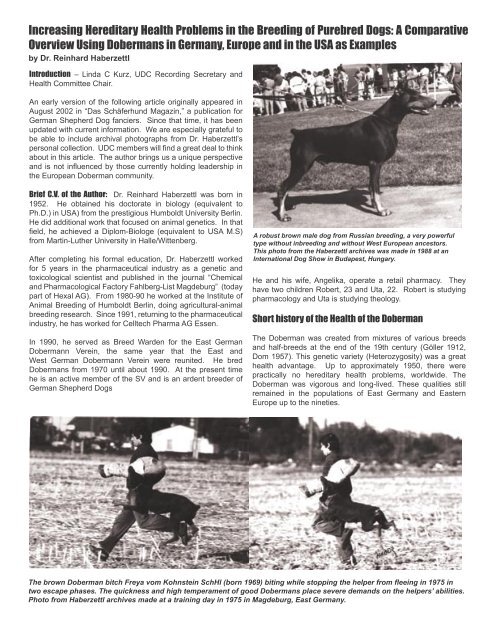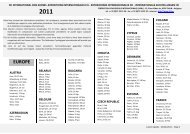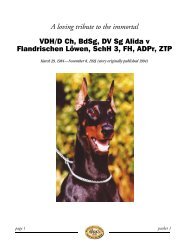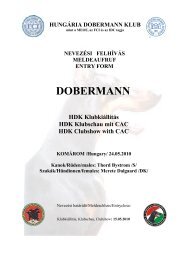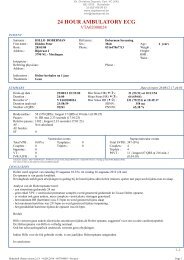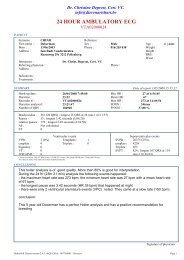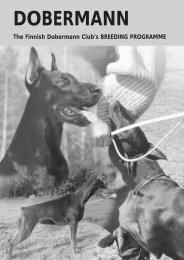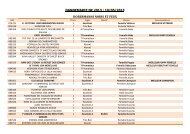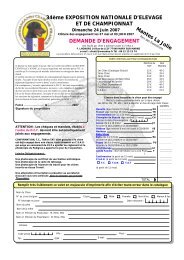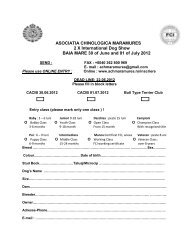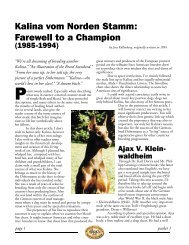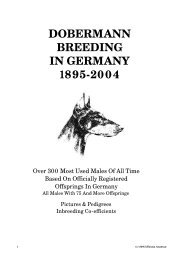Increasing Hereditary Health Problems in the Breeding of Purebred ...
Increasing Hereditary Health Problems in the Breeding of Purebred ...
Increasing Hereditary Health Problems in the Breeding of Purebred ...
- No tags were found...
You also want an ePaper? Increase the reach of your titles
YUMPU automatically turns print PDFs into web optimized ePapers that Google loves.
<strong>Increas<strong>in</strong>g</strong> <strong>Hereditary</strong> <strong>Health</strong> <strong>Problems</strong> <strong>in</strong> <strong>the</strong> Breed<strong>in</strong>g <strong>of</strong> <strong>Purebred</strong> Dogs: A ComparativeOverview Us<strong>in</strong>g Dobermans <strong>in</strong> Germany, Europe and <strong>in</strong> <strong>the</strong> USA as Examplesby Dr. Re<strong>in</strong>hard HaberzettlIntroduction – L<strong>in</strong>da C Kurz, UDC Record<strong>in</strong>g Secretary and<strong>Health</strong> Committee Chair.An early version <strong>of</strong> <strong>the</strong> follow<strong>in</strong>g article orig<strong>in</strong>ally appeared <strong>in</strong>August 2002 <strong>in</strong> “Das Schäferhund Magaz<strong>in</strong>,” a publication forGerman Shepherd Dog fanciers. S<strong>in</strong>ce that time, it has beenupdated with current <strong>in</strong>formation. We are especially grateful tobe able to <strong>in</strong>clude archival photographs from Dr. Haberzettl’spersonal collection. UDC members will f<strong>in</strong>d a great deal to th<strong>in</strong>kabout <strong>in</strong> this article. The author br<strong>in</strong>gs us a unique perspectiveand is not <strong>in</strong>fluenced by those currently hold<strong>in</strong>g leadership <strong>in</strong><strong>the</strong> European Doberman community.Brief C.V. <strong>of</strong> <strong>the</strong> Author: Dr. Re<strong>in</strong>hard Haberzettl was born <strong>in</strong>1952. He obta<strong>in</strong>ed his doctorate <strong>in</strong> biology (equivalent toPh.D.) <strong>in</strong> USA) from <strong>the</strong> prestigious Humboldt University Berl<strong>in</strong>.He did additional work that focused on animal genetics. In thatfield, he achieved a Diplom-Biologe (equivalent to USA M.S)from Mart<strong>in</strong>-Lu<strong>the</strong>r University <strong>in</strong> Halle/Wittenberg.After complet<strong>in</strong>g his formal education, Dr. Haberzettl workedfor 5 years <strong>in</strong> <strong>the</strong> pharmaceutical <strong>in</strong>dustry as a genetic andtoxicological scientist and published <strong>in</strong> <strong>the</strong> journal “Chemicaland Pharmacological Factory Fahlberg-List Magdeburg” (todaypart <strong>of</strong> Hexal AG). From 1980-90 he worked at <strong>the</strong> Institute <strong>of</strong>Animal Breed<strong>in</strong>g <strong>of</strong> Humboldt Berl<strong>in</strong>, do<strong>in</strong>g agricultural-animalbreed<strong>in</strong>g research. S<strong>in</strong>ce 1991, return<strong>in</strong>g to <strong>the</strong> pharmaceutical<strong>in</strong>dustry, he has worked for Celltech Pharma AG Essen.In 1990, he served as Breed Warden for <strong>the</strong> East GermanDobermann Vere<strong>in</strong>, <strong>the</strong> same year that <strong>the</strong> East andWest German Dobermann Vere<strong>in</strong> were reunited. He bredDobermans from 1970 until about 1990. At <strong>the</strong> present timehe is an active member <strong>of</strong> <strong>the</strong> SV and is an ardent breeder <strong>of</strong>German Shepherd DogsA robust brown male dog from Russian breed<strong>in</strong>g, a very powerfultype without <strong>in</strong>breed<strong>in</strong>g and without West European ancestors.This photo from <strong>the</strong> Haberzettl archives was made <strong>in</strong> 1988 at anInternational Dog Show <strong>in</strong> Budapest, Hungary.He and his wife, Angelika, operate a retail pharmacy. Theyhave two children Robert, 23 and Uta, 22. Robert is study<strong>in</strong>gpharmacology and Uta is study<strong>in</strong>g <strong>the</strong>ology.Short history <strong>of</strong> <strong>the</strong> <strong>Health</strong> <strong>of</strong> <strong>the</strong> DobermanThe Doberman was created from mixtures <strong>of</strong> various breedsand half-breeds at <strong>the</strong> end <strong>of</strong> <strong>the</strong> 19th century (Göller 1912,Dom 1957). This genetic variety (Heterozygosity) was a grea<strong>the</strong>alth advantage. Up to approximately 1950, <strong>the</strong>re werepractically no hereditary health problems, worldwide. TheDoberman was vigorous and long-lived. These qualities stillrema<strong>in</strong>ed <strong>in</strong> <strong>the</strong> populations <strong>of</strong> East Germany and EasternEurope up to <strong>the</strong> n<strong>in</strong>eties.The brown Doberman bitch Freya vom Kohnste<strong>in</strong> SchHl (born 1969) bit<strong>in</strong>g while stopp<strong>in</strong>g <strong>the</strong> helper from flee<strong>in</strong>g <strong>in</strong> 1975 <strong>in</strong>two escape phases. The quickness and high temperament <strong>of</strong> good Dobermans place severe demands on <strong>the</strong> helpers’ abilities.Photo from Haberzettl archives made at a tra<strong>in</strong><strong>in</strong>g day <strong>in</strong> 1975 <strong>in</strong> Magdeburg, East Germany.
Between 1970 and 1990 <strong>the</strong> Doberman became a voguebreed <strong>in</strong> <strong>the</strong> USA; this resulted <strong>in</strong> mass over-breed<strong>in</strong>g. Thecauses <strong>of</strong> <strong>the</strong> Doberman’s boom were on <strong>the</strong> one hand <strong>the</strong>grow<strong>in</strong>g security need <strong>of</strong> citizens and on <strong>the</strong> o<strong>the</strong>r hand <strong>the</strong>successful advertisement <strong>of</strong> <strong>the</strong> “protector dog” image <strong>of</strong> <strong>the</strong>breed <strong>in</strong> movies. This role was subsequently taken over by <strong>the</strong>Rottweiler and <strong>the</strong> German Shepherd Dog <strong>in</strong> <strong>the</strong> n<strong>in</strong>eties <strong>in</strong> <strong>the</strong>USA. This over-breed<strong>in</strong>g and <strong>in</strong>breed<strong>in</strong>g <strong>of</strong> Dobermans, takentoge<strong>the</strong>r with <strong>in</strong>sufficient attention to <strong>the</strong>ir hereditary health,has resulted <strong>in</strong> a North American Doberman population that ishighly burdened with 5 hereditary defects (Table 1). Thereforewe are forced to acknowledge a strong degeneration <strong>in</strong> <strong>the</strong>breed that might be hard to repair by means <strong>of</strong> conventionalanimal breed<strong>in</strong>g. The population <strong>of</strong> German and Europeandogs is similarly highly burdened with 2 hereditary defects asa consequence <strong>of</strong> <strong>the</strong> same bad breed<strong>in</strong>g practices as <strong>in</strong> <strong>the</strong>USA. The o<strong>the</strong>r 3 hereditary defects are scarcer <strong>in</strong> Europe, butan <strong>in</strong>crease is now apparent!Freya’s daughter, Anka von der Domstadt, SchH1 (born 1972)dur<strong>in</strong>g <strong>the</strong> attackTable 1: Estimated spread <strong>of</strong> 7 degenerative hereditary diseases as well as <strong>the</strong>ir heritability (estimated value <strong>of</strong> geneticvariance <strong>in</strong> <strong>the</strong> total variance) <strong>in</strong> 3 different Doberman populations. The estimates for East European populations aresomewhat more uncerta<strong>in</strong> because an <strong>in</strong>creas<strong>in</strong>g dilution <strong>of</strong> <strong>the</strong> <strong>in</strong>digenous gene pool has taken place as a consequence<strong>of</strong> imports from Western Europe and <strong>the</strong> USA and additionally because <strong>the</strong>re are fewer reliable sourcesSpread <strong>of</strong> hereditary defects <strong>in</strong>:Disease (Symptoms)1. Dilatedcardiomyopathy, DCM(Sudden death andcongestive heart failure)2. Gastric Volvulus(bloat, shock and death)Heritabilityhighmedium tohighMode <strong>of</strong>Inheritancepolygenetic butmostly autosomally(<strong>in</strong>completely)dom<strong>in</strong>ant (partly X-chromosomal)USAvery highWestern Europe(2004)very high, but <strong>in</strong><strong>the</strong> <strong>in</strong>dividual DCMgenotypes, bigdifferencesEasternEurope (1990)littlepolygenetic high high and <strong>in</strong>creas<strong>in</strong>g! little3. Hypothyroidism (sk<strong>in</strong>problems but variouso<strong>the</strong>r severe symptomspossible)very highseveral genes?monogenetic?high little, but <strong>in</strong>creas<strong>in</strong>g! little4. Von-Willebranddisease = VWD(potentially severebleed<strong>in</strong>g)very highautosomally(<strong>in</strong>completely)recessivemonogenetichigh little, but <strong>in</strong>creas<strong>in</strong>g! little5. Wobbler syndrome(paralyses)very highmonogenetic?polygenetic?high1989 little, but after<strong>the</strong>n, fast <strong>in</strong>creas<strong>in</strong>g;2004 mediumlittle6. PHTVL/PHPV (rang<strong>in</strong>gfrom impaired vision tobl<strong>in</strong>dness)highautosomally(<strong>in</strong>completely)dom<strong>in</strong>antlittlelittle to medium(below 15%)little7. Hip jo<strong>in</strong>t dysplasia–HD, (crippl<strong>in</strong>g arthritisand hip pa<strong>in</strong>)medium polygenetic little little (phenotypebelow 5%)little
For friends <strong>of</strong> dogs and genetic scientists, it is a completely<strong>in</strong>comprehensible fact that even today nei<strong>the</strong>r <strong>in</strong>breed<strong>in</strong>grestrictions, nor exclusions from breed<strong>in</strong>g dogs burdened <strong>in</strong>genotype and <strong>in</strong> phenotype has been <strong>in</strong>itiated --nei<strong>the</strong>r bybreeders nor by <strong>the</strong> breed<strong>in</strong>g authorities <strong>in</strong> almost all Europeancountries (<strong>in</strong>clud<strong>in</strong>g Germany) nor on o<strong>the</strong>r cont<strong>in</strong>ents.While <strong>in</strong> North America <strong>the</strong> great hereditary health problemshave been analyzed and some corrective steps taken <strong>of</strong>fensivelyand honestly, most breed<strong>in</strong>g authorities <strong>in</strong> Europe have made<strong>the</strong> unhelpful claim to <strong>the</strong>ir breeders and to <strong>the</strong> public that <strong>the</strong>reare ei<strong>the</strong>r no or few problems. This is an irresponsible attitude.Un<strong>in</strong>formed purchasers <strong>of</strong> puppies are very disappo<strong>in</strong>ted when<strong>the</strong>ir young dogs fall ill or die <strong>of</strong> cardiomyopathy or volvulus.These hereditary diseases are appear<strong>in</strong>g more <strong>of</strong>ten <strong>in</strong> Europe,because <strong>of</strong> <strong>the</strong> high <strong>in</strong>breed<strong>in</strong>g and unsatisfactory healthtests done on <strong>the</strong> popular breed<strong>in</strong>g animals. This causes highmonetary costs at <strong>the</strong> veter<strong>in</strong>ary cl<strong>in</strong>ic and for medications. Thelife quality <strong>of</strong> <strong>the</strong> dogs (and owners!!) deteriorates as <strong>the</strong> lifeexpectance <strong>of</strong> dogs shortens by years!Breed<strong>in</strong>g <strong>of</strong> Pure Bred Dogs and Good <strong>Health</strong> - Utopia or aReachable Goal?Let me elaborate on some short critical constructive thoughts<strong>of</strong> m<strong>in</strong>e about how to achieve a higher health rate <strong>in</strong> <strong>the</strong> futurebreed<strong>in</strong>g <strong>of</strong> purebred dogs because this concerns almost allbreeds. Well-known veter<strong>in</strong>arians, genetic scientists, breedersand experts <strong>in</strong> animal protection <strong>in</strong>creas<strong>in</strong>gly criticize <strong>the</strong>quality <strong>of</strong> <strong>the</strong> breed<strong>in</strong>g controls imposed by purebred dogs’organizations (AKC, VDH, FCI, etc.) where genetic health isbe<strong>in</strong>g neglected. We <strong>in</strong>sistently demand that genetic healthas a breed<strong>in</strong>g goal must be regarded as just as importantas a breed’s beauty and character. This demand should berespected for all breeds <strong>in</strong> <strong>the</strong> future! The criticism <strong>of</strong> <strong>in</strong>sufficientcare to genetic health <strong>in</strong> 4 areas is summarized below and <strong>the</strong>steps to remedy <strong>the</strong>m are outl<strong>in</strong>ed:1. The breed<strong>in</strong>g for a beautiful conformation must not burden<strong>the</strong> health <strong>of</strong> a breed as a result <strong>of</strong> an extreme <strong>in</strong>terpretation<strong>of</strong> <strong>the</strong> breed standard, but <strong>the</strong> breed standard as applied byjudges at exhibitions must benefit <strong>the</strong> health.2. <strong>Hereditary</strong> defects must not be tolerated <strong>in</strong> conformationbreed<strong>in</strong>g, but <strong>the</strong>y must be quickly elim<strong>in</strong>ated from <strong>the</strong> genepool. Veter<strong>in</strong>ary medical and animal breed<strong>in</strong>g genetic <strong>in</strong>stitutes<strong>of</strong> <strong>the</strong> universities can <strong>of</strong>fer competent assistance. Breed<strong>in</strong>gauthorities, breed<strong>in</strong>g judges, breed<strong>in</strong>g attendants and breedersare not only responsible for <strong>the</strong> beauty and character <strong>of</strong> <strong>the</strong>irpurebred dogs, but every one <strong>of</strong> <strong>the</strong>m must take responsibilityfor countermeasures aga<strong>in</strong>st genetic health defects <strong>in</strong> spite <strong>of</strong>temporary f<strong>in</strong>ancial and/or prestige losses.3. In <strong>the</strong> past, many breed<strong>in</strong>g authorities (not all <strong>of</strong> <strong>the</strong>m) havenot taken sufficient advantage <strong>of</strong> <strong>the</strong> <strong>of</strong>fers <strong>of</strong> universities forassistance to fight hereditary defect or <strong>in</strong> fact ignored <strong>the</strong>mcompletely (Eichelberg 1998). This cooperation is logisticallyexpensive and it makes high demands on <strong>the</strong> responsiblepersons. It also requires honesty, a sense <strong>of</strong> responsibility anda read<strong>in</strong>ess to constantly educate oneself!4. The role <strong>of</strong> uncontrolled <strong>in</strong>breed<strong>in</strong>g should especially berestricted <strong>in</strong> all breeds, because it has led to an accumulation <strong>of</strong>defective genes. In those bloodl<strong>in</strong>es burdened by high numbers<strong>of</strong> hereditary defects, we must completely waive <strong>in</strong>breed<strong>in</strong>g andexclude entirely all breed<strong>in</strong>g <strong>of</strong> animals with any external andhereditary degeneration.In this article I am go<strong>in</strong>g to conf<strong>in</strong>e my discussion to po<strong>in</strong>ts No. 2and 3 with <strong>the</strong> Doberman as example. The <strong>in</strong>sufficient attentionto all 4 po<strong>in</strong>ts <strong>of</strong> criticism <strong>in</strong> many o<strong>the</strong>r breeds has causedan unnecessary decrease <strong>in</strong> <strong>the</strong> public image <strong>of</strong> <strong>the</strong> whole <strong>of</strong>purebred dog breed<strong>in</strong>g <strong>in</strong> <strong>the</strong> last few years. Breeders andbreed<strong>in</strong>g authorities need more self-criticism and more sense <strong>of</strong>responsibility towards <strong>the</strong> breeds as well as towards <strong>the</strong> buyers<strong>of</strong> <strong>the</strong> whelps. If responsible persons <strong>of</strong> breeds burdened byhereditary health defects do not quickly succeed <strong>in</strong> limit<strong>in</strong>g <strong>the</strong>damage, <strong>the</strong>n <strong>the</strong> situation <strong>in</strong> Germany and Europe will developalong a path similar to that observed <strong>in</strong> <strong>the</strong> USA dur<strong>in</strong>g <strong>the</strong> lastdecade (Günter 1996). The numbers <strong>of</strong> purebred dogs be<strong>in</strong>gregistered has dropped rapidly <strong>in</strong> <strong>the</strong> USA (this is particularlytrue for Dobermans) because more and more dog fans preferto pick up a dog from rescue organizations or to purchase ahealthier half-breed. The same situation is now occurr<strong>in</strong>g <strong>in</strong>Germany <strong>in</strong> 2004.The different <strong>in</strong>dividual breeds and different populations <strong>of</strong> <strong>the</strong>same breed can be heavily burdened with hereditary defectsnationally and <strong>in</strong>ternationally <strong>in</strong> very different ways. Hip jo<strong>in</strong>tdysplasia (HD) is a good example. There are some very heavyburdened breeds: St. Bernard, Leonberger, German ShepherdDog and o<strong>the</strong>rs. However, success <strong>in</strong> <strong>the</strong> fight aga<strong>in</strong>st it hasbeen very different accord<strong>in</strong>g to <strong>the</strong> commitment <strong>of</strong> breeders.The Hovawart represents a very especial positive examplewhere much progress has been made. Concern<strong>in</strong>g <strong>the</strong> GermanShepherd Dog, success <strong>of</strong> <strong>the</strong> fight aga<strong>in</strong>st HD is very differentfrom country to country (Willis 1994). In <strong>the</strong> countries where<strong>the</strong>re are good descendant records, <strong>the</strong> dogs carry<strong>in</strong>g HD canbe identified <strong>in</strong> spite <strong>of</strong> an external impeccable hip (phenotypetype good, gene type bad) and <strong>the</strong>y could be excluded frombreed<strong>in</strong>g with <strong>the</strong> result that <strong>the</strong> frequency <strong>of</strong> diseased hipswould strongly decrease. However, at <strong>the</strong> SV <strong>the</strong>y have beenunsuccessful as this recommendation has not been followed.For examples <strong>in</strong> <strong>in</strong>dividual breeds; <strong>the</strong> Airedale-Terrier andDoberman have a very low HD burden, and almost 100 percent<strong>of</strong> greyhound breeds and all wild dogs, (e.g. <strong>the</strong> wolf) aregenerally HD-free. In <strong>the</strong> worldwide view, <strong>the</strong> Doberman has arelatively healthy hip. S<strong>in</strong>ce <strong>the</strong> beg<strong>in</strong>n<strong>in</strong>g <strong>of</strong> X-ray exam<strong>in</strong>ations30 years ago <strong>in</strong> Germany, <strong>the</strong> number <strong>of</strong> Dobermans withnormal hips has almost constantly been at over 90 percent;thus breed<strong>in</strong>g practices have caused nei<strong>the</strong>r deterioration norimprovement. Table I summarizes this HD problem and <strong>the</strong>o<strong>the</strong>r 6 hereditary Doberman health problems. The follow<strong>in</strong>gtext briefly discusses each <strong>of</strong> <strong>the</strong>se 6 and makes comparisonto o<strong>the</strong>r breeds.1 st feature Sudden death by heart failure (cardiomyopathy)Many dog breeds are affected with vary<strong>in</strong>g frequency, but <strong>the</strong>DCM death-rate for <strong>the</strong> Doberman takes <strong>the</strong> sad first placeboth <strong>in</strong> <strong>the</strong> USA and <strong>in</strong> Germany. Mr. Kraft (1989), from <strong>the</strong>University <strong>of</strong> Munich, presents heart death statistics fromdissection materials <strong>of</strong> different pathological <strong>in</strong>stitutes, wherefrequently <strong>the</strong> Doberman rate stands ahead <strong>of</strong> <strong>the</strong> Great Dane,<strong>the</strong> St. Bernard and <strong>the</strong> German Shepherd Dog. Fur<strong>the</strong>rmore,Pr<strong>of</strong>. Kraft presents <strong>the</strong> result <strong>of</strong> a regional survey <strong>of</strong> Doberman
Club (VDH) from South Germany. From 92 cases <strong>of</strong> death,24 died <strong>of</strong> death by heart failure. The extensive statistics <strong>of</strong>death by heart failure <strong>in</strong> purebred dogs by Calvert and Pickus(1989) from <strong>the</strong> USA looks like <strong>the</strong> situation <strong>in</strong> Germany. TheDoberman by far leads <strong>the</strong> Great Dane, <strong>the</strong> Irish Wolf houndand <strong>the</strong> St. Bernard.Affected Dobermans can die at 2 months, 12 months, 3 years,7 years or 11 years –<strong>the</strong> age <strong>of</strong> DCM death <strong>in</strong> any <strong>in</strong>dividualaffected Doberman depends upon how many <strong>of</strong> <strong>the</strong> DCM geneshe has received from his sire and dam (van der Zwan 1987).Quantitatively, DCM has a polygenetic mode <strong>of</strong> <strong>in</strong>heritance(Table 1). The greater <strong>the</strong> number <strong>of</strong> DCM genes <strong>in</strong>herited, <strong>the</strong>earlier <strong>the</strong> dog will die, less than 5 years old. If he has <strong>in</strong>heritedonly a few <strong>of</strong> <strong>the</strong> DCM genes, <strong>the</strong>n he will not die <strong>of</strong> it till he isan old dog (over 9 years old) or perhaps not show<strong>in</strong>g DCM atall, dy<strong>in</strong>g <strong>of</strong> someth<strong>in</strong>g else first.Both <strong>in</strong> North America and <strong>in</strong> Europe an <strong>in</strong>creas<strong>in</strong>g reduction<strong>in</strong> <strong>the</strong> age <strong>of</strong> death seems apparent (Kollenberg 1998). Ingeneral two forms <strong>of</strong> disease progression (Type A and B) canbe identified <strong>in</strong> <strong>the</strong> Doberman depend<strong>in</strong>g on how suddenly <strong>the</strong>dogs die and by o<strong>the</strong>r features (van der Zwan 1987, Schüler1997).Type A: Arrhythmia. For this type, <strong>the</strong> death occurs suddenly,allegedly without (??) any warn<strong>in</strong>g. The dog collapses and dies.Diagnosis <strong>of</strong> <strong>the</strong> dog’s arrhythmia is possible by us<strong>in</strong>g long-termECG (Holter record<strong>in</strong>g) as is done for human be<strong>in</strong>gs.Type B: Congestive Heart Failure. This type shows a l<strong>in</strong>ger<strong>in</strong>gdevelopment <strong>of</strong> symptoms for a prolonged period. The dogs<strong>of</strong>ten cough <strong>in</strong> <strong>the</strong> morn<strong>in</strong>g as a result <strong>of</strong> water accumulation<strong>in</strong> <strong>the</strong> lungs. Diagnostically, heart enlargements and vesselchanges can be detected a long time before <strong>the</strong> death.A partly X-chromosome and predom<strong>in</strong>antly autosomally (atdifferent chromosomes) polygene hereditary transmission canbe assumed, because accord<strong>in</strong>g to <strong>the</strong> statistics approx. 57%<strong>of</strong> all Dobermans <strong>in</strong> Germany and 67% <strong>in</strong> USA, that died byheart failure, are male dogs.The noticeable frequency <strong>of</strong> death cases over severalgenerations (Fig. 1) can be identified <strong>in</strong> <strong>the</strong> German andAmerican Doberman’s pedigree trees. The heritability <strong>of</strong> <strong>the</strong>sudden death by heart failure must be assessed as mediumto high.Fig. I Pedigree for heredity <strong>of</strong> heart muscle disease (cardiomyopathy, type B) from a US breed<strong>in</strong>g pattern accord<strong>in</strong>g to Calvert and Pickus(1989) over four generations. Grandfa<strong>the</strong>r, son and grandson fell ill and each <strong>of</strong> <strong>the</strong>m was mated with healthy bitches. The grandson begot alitter <strong>of</strong> 5 whelps, 4 (3,1) <strong>of</strong> <strong>the</strong>m fell illJason v. Nymphenburg, born 1982. His owner Mart<strong>in</strong>a Kelb <strong>in</strong>Berl<strong>in</strong>, breeder under kennel name “Novlis”, made this photo. ManyNymphenburg Dobermans were <strong>the</strong> major w<strong>in</strong>ners <strong>of</strong> German andEuropean shows <strong>in</strong> <strong>the</strong> 80s and 90s: A<strong>the</strong>ne, Athos, Berenike, Bellona,Diana, Far<strong>in</strong>a, Feus, Jaron, Jason, Orpheus and o<strong>the</strong>rs. They had agreat <strong>in</strong>fluence on <strong>the</strong> breed. Most died by DCM or volvulus because<strong>the</strong>y had many genes for both diseases.Ilg v. Amtmannsgarten, born 1985; an elegant but oversized blackmale dog, strongly <strong>in</strong>bred from West German breed<strong>in</strong>g, withdeath by heart failure (Fa<strong>the</strong>r: Jason von Nymphenburg.) Photois from <strong>the</strong> Haberzettl archives
Eos v.d. Dobermannstadt, born 1986, stand<strong>in</strong>g <strong>in</strong> a show poseat left.The bottom two photos (left) are from his first SchHIII trial <strong>in</strong>1988 dur<strong>in</strong>g <strong>the</strong> attack by <strong>the</strong> helper and at <strong>the</strong> hold and bark.He died <strong>of</strong> DCM at 8.5 years. Up to his death <strong>in</strong> 1994, he madeSchH III many times with his owner and tra<strong>in</strong>er Vokhard Haun,(breeder, “v.d. Fixe Idee”). Eos’ breeder was Walter Hacket,Apolda. Eos’ bro<strong>the</strong>r Euros also died <strong>of</strong> DCM at <strong>the</strong> age <strong>of</strong> 9.Ano<strong>the</strong>r bro<strong>the</strong>r, Enos, died <strong>of</strong> bloat at only 9 months <strong>of</strong> age.Fa<strong>the</strong>r: Jason v. Nympenburg, West Germany, died <strong>of</strong> DCMat 7 years. Jason’s three litter-bro<strong>the</strong>rs and <strong>the</strong>ir mo<strong>the</strong>r andone grandfa<strong>the</strong>r also died <strong>of</strong> DCM at ages rang<strong>in</strong>g from 4 to 8years old.Mo<strong>the</strong>r: Asta v.d. Dobermannstadt, East Germany, phenotypeand genotype without DCM. (pictured below)The E-litter v.d. Dobermannstadt was an outcross breed<strong>in</strong>gbetween Asta and Jason. It took place <strong>in</strong> 1985 <strong>in</strong> <strong>the</strong> garden <strong>of</strong>Haberzettl’s <strong>in</strong> East Berl<strong>in</strong>. In <strong>the</strong> result<strong>in</strong>g litter, one bro<strong>the</strong>rand two sisters <strong>of</strong> Eos and Euros probably have had no DCM<strong>in</strong> phenotype. Eos was bred with 55 East German bitches(all free <strong>of</strong> cardio <strong>in</strong> phenotype and genotype) produc<strong>in</strong>g 340progeny, with not one develop<strong>in</strong>g DCM phenotype 10 yearsafter Eos’ last pups were whelped! There must have been adilution effect <strong>of</strong> <strong>the</strong> DCM genes from Jason v. Nymphenburg<strong>in</strong> his pups <strong>in</strong> <strong>the</strong> first and second filial generation aftercross<strong>in</strong>g Jason and his son Eos to DCM free bitches <strong>in</strong> EastGermany.Asta v.d. Dobermannstadt,Best bitch <strong>in</strong> Show Biesdorf1984, Dam <strong>of</strong> DobermannstadtE litter. Asta was free <strong>of</strong> DCM<strong>in</strong> phenotype and genotype
2 nd feature: Volvulus (Bloat and Gastric Torsion)Volvulus appears <strong>in</strong> many large breeds with differ<strong>in</strong>g frequency.It is a life threaten<strong>in</strong>g disease and emergency veter<strong>in</strong>arytreatment is required to enable <strong>the</strong> dog to survive. Accord<strong>in</strong>gto Willis (1994), <strong>the</strong> German Shepherd Dog, <strong>the</strong> Berner Sennendog and <strong>the</strong> Doberman are most frequently affected <strong>in</strong> Europe.In <strong>the</strong> USA, <strong>the</strong> death statistics <strong>of</strong> 26 breeds (Schüler 1997),<strong>in</strong>dicate that <strong>the</strong> German Shepherd Dog, <strong>the</strong> St. Bernhardand <strong>the</strong> Weimaraner are especially heavily affected. In breedcomparison, <strong>the</strong> Doberman is only <strong>in</strong> <strong>the</strong> 8 th place here, howevera strong <strong>in</strong>crease is evident <strong>in</strong> Europe. From 1964 till 1994 <strong>the</strong>cl<strong>in</strong>ic admissions <strong>of</strong> Dobermans for bloat have dramatically<strong>in</strong>creased by 1500%. Of all 92 registered death cases <strong>of</strong>Dobermans <strong>in</strong> South Germany, 15 (16%) died <strong>of</strong> volvulus. InGermany, many Dobermans were even successfully operatedon twice dur<strong>in</strong>g <strong>the</strong>ir life and <strong>the</strong>n <strong>the</strong>y were used for breed<strong>in</strong>g.An <strong>in</strong>crease <strong>of</strong> volvulus with<strong>in</strong> def<strong>in</strong>ite bloodl<strong>in</strong>es is noted - <strong>the</strong>genetic basic is clear, but environmental factors play a role aswell. The heredity pattern is not yet exactly known. Because<strong>of</strong> <strong>the</strong> fact that volvulus is subject to environmental factors(e.g. fill<strong>in</strong>g quantity <strong>in</strong> stomach, movement or rest after <strong>the</strong>meals, anatomical special features <strong>of</strong> <strong>the</strong> form <strong>of</strong> <strong>the</strong> rib cageand rib width and o<strong>the</strong>rs), we can assume that <strong>the</strong> heredityis polygenetic. At <strong>the</strong> moment <strong>the</strong> heritability can be judgedas medium to high. Until 1990, bloat and torsion <strong>in</strong> <strong>the</strong> EastGerman Doberman population was under 2 %. After 1990,20 % <strong>of</strong> German Dobermans were dy<strong>in</strong>g <strong>of</strong> bloat with torsion.Much more than 20% must have a genotype predispos<strong>in</strong>g tovolvulus.3 rd feature: HypothyroidismBesides <strong>the</strong> Doberman, <strong>the</strong> Husky, Malamute, Labrador andBeagle are also burdened with this hereditary defect (Willis1994). Accord<strong>in</strong>g to Dodds (1988), over 60 % <strong>of</strong> Dobermans <strong>in</strong><strong>the</strong> USA are hypothyroid. Similar to <strong>the</strong> disease <strong>in</strong> humans, ifit is left untreated, hypothyroidism leads to various, unspecificdisease symptoms <strong>in</strong> <strong>the</strong> dog, e.g. hair and sk<strong>in</strong> illnesses,muscle and nervous diseases, loss or ga<strong>in</strong> <strong>of</strong> weight, digestivetroubles, <strong>in</strong>fections and o<strong>the</strong>r symptoms. Quality <strong>of</strong> life and lifeexpectancy are greatly reduced without hormone treatment.Hypothyroidism is comparatively easy to diagnose and easy totreat. Giv<strong>in</strong>g <strong>the</strong> hormone daily <strong>in</strong> pill form benefits greatly <strong>the</strong>diseased Dobermans. However, if breed<strong>in</strong>g is be<strong>in</strong>g pursuedwith <strong>the</strong>se diseased dogs, <strong>the</strong>n <strong>the</strong>re <strong>the</strong> breed is existentiallyendangered. Hypothyroidism can exacerbate <strong>the</strong> symptoms <strong>of</strong>o<strong>the</strong>r diseases such as: cardiomyopathy, vWD and Wobblersyndrome. The heritability <strong>of</strong> hypothyroidism is estimated tobe as high as 90 percent (Dodds 1988). Therefore <strong>the</strong> effect <strong>of</strong>environmental factors is small (with <strong>the</strong> exception <strong>of</strong> hormonesubstitution!). A mutation <strong>of</strong> one or only few genes can beassumed.4 th feature: von Willebrand disease (= vWD-bleeder)The “von Willebrand disease” is a very special bloodcoagulation disorder with a significant health risk that can betransmitted autosomally <strong>in</strong>completely (Haberzettl 2004) througha recessive simple monogenetic mode <strong>of</strong> <strong>in</strong>heritance (Brewer1999). Completely (100%) recessive and completely dom<strong>in</strong>antmonogenetic <strong>in</strong>heritable diseases and features <strong>in</strong> both animalsand humans are very rare; most monogenetic diseases havea mode <strong>of</strong> <strong>in</strong>heritance between recessive and dom<strong>in</strong>ant (Freye1976, Strachan and Read 1996). But most genetic defects <strong>in</strong>humans and dogs alike are not monogenetic but polygeneticwith a complex quantitative mode <strong>of</strong> heredity, similar to that <strong>of</strong> hipjo<strong>in</strong>t dysplasia. The vWD mode <strong>of</strong> <strong>in</strong>heritance is “<strong>in</strong>completely”recessive because carrier animals (Aa) have plasma levels <strong>of</strong>factor 8 (von Willebrand’s prote<strong>in</strong>)<strong>in</strong>termediate between those<strong>of</strong> “clear” (AA) and “affected” (aa) animals. This is <strong>in</strong> contrast toa “completely” recessive mode <strong>of</strong> <strong>in</strong>heritance as illustrated by<strong>the</strong> brown (b) and black (B) color genes. BB and Bb dogs are“completely” black and only bb dogs are brown. Bb dogs thatare carriers <strong>of</strong> <strong>the</strong> brown gene are not <strong>of</strong> an <strong>in</strong>termediate color.In contrast, Aa dogs that are carriers <strong>of</strong> <strong>the</strong> vWD gene have<strong>in</strong>termediate levels <strong>of</strong> <strong>the</strong> factor <strong>in</strong> <strong>the</strong>ir blood.Molecular genetics has made <strong>the</strong> situation relatively clear.This complex situation is now understood to arise because<strong>the</strong> genetic defect giv<strong>in</strong>g rise to vWD (<strong>in</strong> <strong>the</strong> Doberman andManchester Terrier but not <strong>in</strong> all o<strong>the</strong>r breeds affected byvWF deficiency accord<strong>in</strong>g to VetGen) is not <strong>in</strong> <strong>the</strong> gene for<strong>the</strong> prote<strong>in</strong> factor itself but <strong>in</strong> <strong>the</strong> DNA sequence controll<strong>in</strong>g<strong>the</strong> construction <strong>of</strong> <strong>the</strong> gene message from its separate partson <strong>the</strong> chromosome. This is called a splice defect. S<strong>in</strong>ce <strong>the</strong>fidelity <strong>of</strong> this splic<strong>in</strong>g process is never 100%, a small amount<strong>of</strong> normal factor is produced even <strong>in</strong> <strong>the</strong> case <strong>of</strong> dogs carry<strong>in</strong>gtwo defective genes (Kurz, 2004). The <strong>in</strong>heritance <strong>of</strong> <strong>the</strong>potential to bleed is simple. Normal levels <strong>of</strong> <strong>the</strong> factor are onlypresent <strong>in</strong> animals with two normal genes. The potential forsevere bleed<strong>in</strong>g is most serious <strong>in</strong> animals with two defectivegenes but even here it is not automatic because some smallamounts <strong>of</strong> normal factor are still made by “mistake”, Whe<strong>the</strong>ran affected animal (or less likely a carrier) actually bleedsdepends upon o<strong>the</strong>r genes or environmental factors. Althoughconfidence <strong>in</strong> this explanation is high, it has failed to appear<strong>in</strong> <strong>the</strong> peer-reviewed scientific literature as a consequence <strong>of</strong>patent concerns and commercialization <strong>of</strong> <strong>the</strong> DNA test.Breed<strong>in</strong>g results (statistical) <strong>in</strong> all breeds from <strong>the</strong> 6 possible genetic comb<strong>in</strong>ations “A” represents <strong>the</strong> normal gene and “a”represents <strong>the</strong> mutated gene:Both parents carrier (Aa x Aa): Ú puppies 25 % affected (aa), 50% carrier (Aa), 25% clear (AA)Both parents clear (AA x AA): Ú puppies 100% clear (AA)Both parents affected (aa x aa): Ú puppies 100% affected (aa)One parent carrier and one clear (Aa x AA): Ú puppies 50% carrier (Aa), 50% clear (AA)One parent carrier and one affected (Aa x aa): Ú puppies 50% carrier (Aa), 50% affected (aa)One parent affected and one clear (aa x AA): Ú puppies 100% carrier (Aa)
The vWD gene frequency <strong>in</strong> <strong>the</strong> American Doberman populationis very high: approximately 30% are homozygote affected,50% are carriers (heterozygote vWD, leav<strong>in</strong>g only 20% <strong>of</strong>dogs completely clear <strong>in</strong> phenotype and homozygote free <strong>of</strong>vWD genes <strong>in</strong> genotype (Kurz 2004). Probably <strong>the</strong> EuropeanDoberman is still only lightly burdened with vWD genes at <strong>the</strong>moment but exact figures do not exist. Fur<strong>the</strong>r <strong>in</strong>crease can beexpected also <strong>in</strong> <strong>the</strong> European Doberman because <strong>the</strong> breedershave taken only limited actions towards limit<strong>in</strong>g <strong>the</strong> damage.The extensive North American experience could be helpful<strong>in</strong> Europe. The vWD is found <strong>in</strong> 57 o<strong>the</strong>r breeds <strong>of</strong> purebreddogs: German shepherd dog, Corgi, Sheltie, Golden Retriever,Manchester terrier, poodles and many o<strong>the</strong>r breeds (Willis 1992,Schueler 1997), but <strong>the</strong> gene frequencies are lower than <strong>in</strong> <strong>the</strong>Doberman. For several o<strong>the</strong>r breeds, <strong>the</strong> homozygote-affecteddogs are subject to potentially lethal episodes <strong>of</strong> external and<strong>in</strong>ternal bleed<strong>in</strong>g that can occur any time and must be treated bya veter<strong>in</strong>arian. But fortunately homozygote Doberman bleederscan still produce a small amount (5-10%) <strong>of</strong> normal factor (Kurz2004) provid<strong>in</strong>g some protection aga<strong>in</strong>st uncontrolled bleed<strong>in</strong>gand mak<strong>in</strong>g <strong>the</strong> disease milder for affected Dobermans.The symptoms (phenotypes) shown by affected and carrierDobermans have such great variability because <strong>the</strong> actual vWFlevels <strong>in</strong> both affected and carrier can vary widely <strong>in</strong> differentdogs and also <strong>in</strong> <strong>the</strong> same dog at various times <strong>in</strong> his life. Thesegreat phenotypical variations must arise from <strong>in</strong>teractions <strong>of</strong> <strong>the</strong>vWD gene with o<strong>the</strong>r (unknown) genes and to environmentalfactors <strong>in</strong> <strong>the</strong> <strong>in</strong>dividual Doberman (stress, high <strong>in</strong>breed<strong>in</strong>g,hypothyroidism, o<strong>the</strong>r diseases or factors). There is also <strong>the</strong>possibility that we have more than one deleterious mutation <strong>in</strong><strong>the</strong> vW genes or different alleles at <strong>the</strong> same gene locus, sothat <strong>the</strong> prote<strong>in</strong>s <strong>in</strong> phenotypes <strong>of</strong> different affected and carrierDobermans are different. Research is cont<strong>in</strong>u<strong>in</strong>g (CornellVeter<strong>in</strong>ary School).In genotype, both carriers and affected dogs differ only <strong>in</strong> <strong>the</strong>degree <strong>of</strong> penetrance <strong>of</strong> <strong>the</strong> defective gene (Dodds 1988).That is, a carrier although outwardly a healthy Doberman is notvigorous, <strong>in</strong> <strong>the</strong> sense that it does not have <strong>the</strong> same reservesas a normal dog to withstand environmental stress. If a vWDcarrier becomes hypothyroid, it may be subject to bleed<strong>in</strong>gepisodes unless placed on thyroid supplement.The exact nature <strong>of</strong> breed<strong>in</strong>g practice (<strong>in</strong>breed<strong>in</strong>g oroutcross<strong>in</strong>g) can have a great <strong>in</strong>fluence on vitality. S<strong>in</strong>ce 1970breed<strong>in</strong>g <strong>of</strong> affected animals has slowed <strong>in</strong> <strong>the</strong> US but it is<strong>in</strong>creas<strong>in</strong>g <strong>in</strong> <strong>the</strong> Ne<strong>the</strong>rlands, Italy, Norway, and Hungary. InGermany, <strong>the</strong>re is almost complete <strong>in</strong>attention to this problemeven by <strong>the</strong> most prestigious breeders; <strong>the</strong> vWD status <strong>of</strong> <strong>the</strong>European population should be checked most urgently.The new American DNA test is an excellent, simple methodthat <strong>the</strong> European Doberman breeder could use to prevent an<strong>in</strong>crease from <strong>the</strong> low gene frequency <strong>in</strong> <strong>the</strong> European Dobermanpopulation to <strong>the</strong> high gene frequency <strong>in</strong> North America. Theold prote<strong>in</strong>-based method was completely unreliable for carrierdetection because <strong>of</strong> <strong>the</strong> great <strong>in</strong>dividual variation <strong>in</strong> phenotype(<strong>the</strong> plasma levels <strong>of</strong> normal VWD-prote<strong>in</strong>.) The vWD DNA testis valid lifelong for every dog. The DNA test report is given as“clear or “carrier” or “affected”. This one result for one dog isdef<strong>in</strong>itive and f<strong>in</strong>al. Retest<strong>in</strong>g is po<strong>in</strong>tless, because <strong>the</strong> resultwill always be <strong>the</strong> same for a given animal (Brewer 1999).After identify<strong>in</strong>g all carriers <strong>in</strong> <strong>the</strong> breed<strong>in</strong>g population Americanbreeders could quickly reduce <strong>the</strong> disease gene frequency.First <strong>the</strong> simple monogenetic mode <strong>of</strong> heredity and second<strong>the</strong> DNA test give <strong>the</strong> American breeder a very good chanceto elim<strong>in</strong>ate VWD disease <strong>in</strong> future generations. In fact, this isoccurr<strong>in</strong>g (Kurz, 2004).5 th feature: Wobbler syndrome (paralysis)The Wobbler syndrome is a hereditary degenerative disease<strong>of</strong> <strong>the</strong> neck sp<strong>in</strong>al column, occurr<strong>in</strong>g most commonly <strong>in</strong> middleage. Deformed <strong>in</strong>tervertebral discs and sp<strong>in</strong>e bodies constrict<strong>the</strong> nerve tissues <strong>in</strong> <strong>the</strong> sp<strong>in</strong>al cord, so that pa<strong>in</strong>, movementdisorders and paralysis occur. Surgery is <strong>the</strong> only successfultreatment. Besides <strong>the</strong> Doberman, such cases are alsopresent <strong>in</strong> <strong>the</strong> German Shepherd Dog, Basset and Barsoi.Accord<strong>in</strong>g to Schüler (1997), <strong>the</strong> American Doberman has ahigher occurrence than <strong>the</strong> European. However, exact figuresare known nei<strong>the</strong>r for North America nor for Europe. Theexact heredity <strong>of</strong> <strong>the</strong> syndrome is not clear, primarily because<strong>the</strong>re is far too little cooperation <strong>of</strong> <strong>the</strong> breeder clubs with<strong>the</strong> Universities. Van der Zwan (1987) supposes a polygeneheredity symptom with probable high heritability.6th Feature: Degenerative eye diseases (PHTVL/PHPV)Impaired vision up to full loss <strong>of</strong> <strong>the</strong> sight is <strong>the</strong> result <strong>of</strong> geneticconditioned degeneration <strong>of</strong> <strong>the</strong> eye and occurs <strong>in</strong> severalbreeds with different frequently. Accord<strong>in</strong>g to Willis (1994)<strong>the</strong> Staffordshire Bull Terrier, Basenji and <strong>the</strong> Doberman areaffected most strongly by PHTVL/PHPV. This is a disorder <strong>of</strong> afetal development <strong>of</strong> <strong>the</strong> eye that results <strong>in</strong> large and small spotsand turbidity on <strong>the</strong> eye; <strong>the</strong> spots are caused by <strong>the</strong> persistent(that would normally disappear) embryonic membranes andblood vessels.It is assumed to be an autosomal <strong>in</strong>completely dom<strong>in</strong>an<strong>the</strong>redity (Schüler 1997) and a high heritability should beexpected. The abbreviations mean: PHTVL persistent hyperplasticTunica vascularis lentis, PHPV persistent hyper-plasticprimary Vitreum.While this disease is presently very rare <strong>in</strong> <strong>the</strong> AmericanDoberman, it can be expected to <strong>in</strong>crease with <strong>the</strong> arrival <strong>of</strong>European imports unless vigilance is practiced. Dogs wi<strong>the</strong>ven mild degrees <strong>of</strong> this disorder should not be bred as aconsequence <strong>of</strong> <strong>the</strong> <strong>in</strong>complete dom<strong>in</strong>ant heredity; Dogs withmild degrees <strong>of</strong> this defect can produce bl<strong>in</strong>d whelps.Conclusions for all breedsThrough <strong>the</strong> negative example <strong>of</strong> <strong>the</strong> Doberman <strong>in</strong> Germany,Europe and <strong>the</strong> USA, <strong>the</strong> reader can see that <strong>in</strong> less than20 years <strong>the</strong> Doberman changed from a very healthy, vitaland long-lived dog breed to a breed that is susceptible todisease with an average life-expectancy less than 7 years(West Germany 1989). The genetic degeneration <strong>of</strong> <strong>the</strong>whole population worldwide has progressed as a result <strong>of</strong>breed<strong>in</strong>g with sick animals (phenotype and genotype). Theaverage life-expectancy <strong>of</strong> over 5 years can be reached formany <strong>in</strong>dividual dogs only with great f<strong>in</strong>ancial veter<strong>in</strong>arianexpenditures (e.g. 1 pill <strong>of</strong> thyroid gland hormone daily, heart
drugs, frequent surgical operations aga<strong>in</strong>st Wobbler andBloat, blood coagulation compounds, drugs aga<strong>in</strong>st Demodeximmunity defect and o<strong>the</strong>rs)!! Generally for all breeds withfrequent health problems, veter<strong>in</strong>arian-medical measures(diagnostics and <strong>the</strong>rapy) are not enough for <strong>the</strong> breed<strong>in</strong>ganimals, Additionally <strong>the</strong> gene pool <strong>of</strong> <strong>the</strong> whole breed<strong>in</strong>gpopulation must be improved by means <strong>of</strong> <strong>in</strong>telligent animalbreed<strong>in</strong>g and genetic breed<strong>in</strong>g strategies i.e. especially by aneffective selection <strong>of</strong> breed<strong>in</strong>g dogs without heredity defects.The follow<strong>in</strong>g veter<strong>in</strong>ary and animal breed<strong>in</strong>g measures shouldbe achieved toge<strong>the</strong>r:1. All breed<strong>in</strong>g animals should provide a certificate <strong>of</strong>standardized exam<strong>in</strong>ation by University cl<strong>in</strong>ics cover<strong>in</strong>g allproblem features <strong>of</strong> <strong>the</strong> breed (e.g. 5 features for <strong>the</strong> Dobermanlisted <strong>in</strong> Table 1). This certificate could also be used to makea close connection between breed<strong>in</strong>g, health and exhibition<strong>in</strong>g.In o<strong>the</strong>r words, w<strong>in</strong>n<strong>in</strong>g show dogs must prove <strong>the</strong>ir healthsuperiority as well as be<strong>in</strong>g beautiful breed specimens.2. The carry<strong>in</strong>g out <strong>of</strong> <strong>the</strong>se exam<strong>in</strong>ations requiresdedicated, logistical preparations and arrangements betweenbreed<strong>in</strong>g authorities and universities, but <strong>the</strong> first step mustalways come from <strong>the</strong> breed<strong>in</strong>g authorities that must provideleadership.3. Inbreed<strong>in</strong>g and pattern breed<strong>in</strong>g (wide <strong>in</strong>breed<strong>in</strong>g)us<strong>in</strong>g breed<strong>in</strong>g animals from <strong>the</strong> bloodl<strong>in</strong>es with <strong>in</strong>creasedhealth risk (e. g. for death by heart failure and volvulus at <strong>the</strong>Doberman) must stop. The breed<strong>in</strong>g authorities must develop<strong>in</strong>telligent external breed<strong>in</strong>g strategies for <strong>the</strong>ir members,where health test<strong>in</strong>g breed<strong>in</strong>g animals would be <strong>the</strong> firstpriority.4. The VDH (nationally <strong>in</strong> Germany), <strong>the</strong> AKC (<strong>in</strong> <strong>the</strong> USA)and <strong>the</strong> FCI (<strong>in</strong>ternationally) should write <strong>the</strong> genetic health as<strong>the</strong> 1 st breed<strong>in</strong>g goal <strong>of</strong> <strong>the</strong> purebred dog on <strong>the</strong>ir banners. For<strong>in</strong>stance, by <strong>the</strong> reform <strong>of</strong> conformation shows (Herzog 1998),<strong>the</strong> registration organizations <strong>of</strong> <strong>the</strong> purebred dog breed couldmandate favor<strong>in</strong>g show dogs and breed<strong>in</strong>g dogs with healthcertificates dur<strong>in</strong>g <strong>the</strong> award <strong>of</strong> w<strong>in</strong>ner titles and dur<strong>in</strong>g plac<strong>in</strong>g.In such a way <strong>the</strong> health, as <strong>the</strong> breed<strong>in</strong>g goal, could beconsiderably promoted. Innovative, combat strategies aga<strong>in</strong>s<strong>the</strong>reditary diseases, specifically for severely affected breedslike <strong>the</strong> Doberman (promoted and controlled by VDH and FCI)could improve <strong>the</strong> shaken reputation <strong>of</strong> <strong>the</strong> purebred dog <strong>in</strong>public, but first <strong>of</strong> all for <strong>the</strong> benefit <strong>of</strong> our dogs.Mr. Bernd Przadka with <strong>the</strong> Doberman bitch Tendy vom Schrotturmm,SchH III dur<strong>in</strong>g <strong>the</strong> obedience phase. The Schutzhund sport obediencephase <strong>in</strong> East Germany had some exercises (dog walk) not <strong>in</strong>cluded<strong>in</strong> <strong>the</strong> sport today.Tendy vom Schrotturm, SchH III dur<strong>in</strong>g <strong>the</strong> attack (right). Thesephotos were taken by Dr. Haberzettl at a SchHII trial <strong>in</strong> 1987 <strong>in</strong> EastBerl<strong>in</strong>. Tendy was purchased as a pup (whelped 1984) and tra<strong>in</strong>ed forprotection by her owner Mr. Przakda, Director <strong>of</strong> Security at <strong>the</strong> Berl<strong>in</strong>-Schoenefeld Airport, after a very brutal hold-up as he was jogg<strong>in</strong>gthrough a Berl<strong>in</strong> park.


